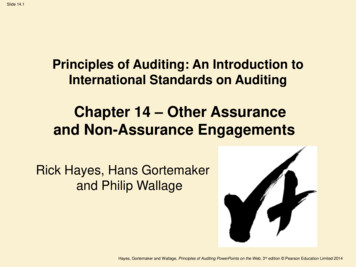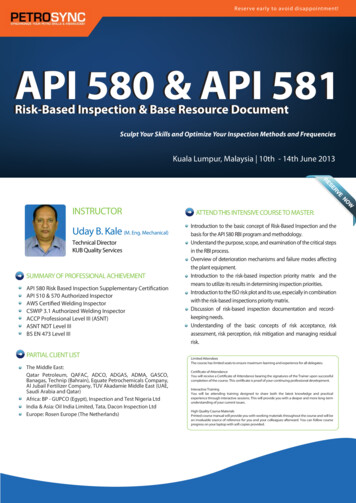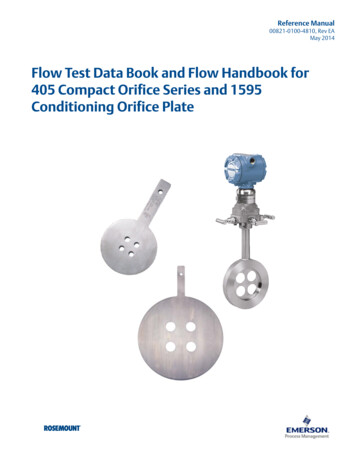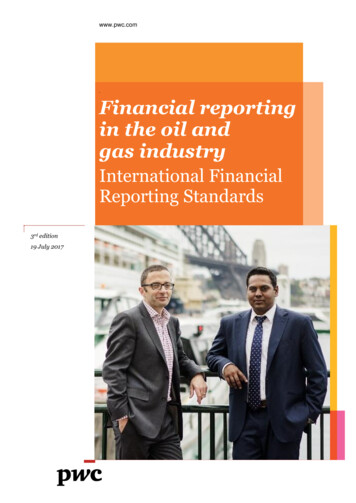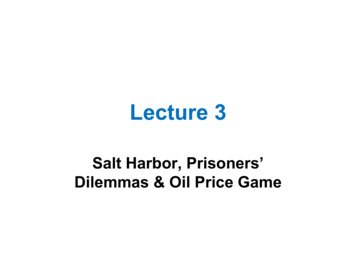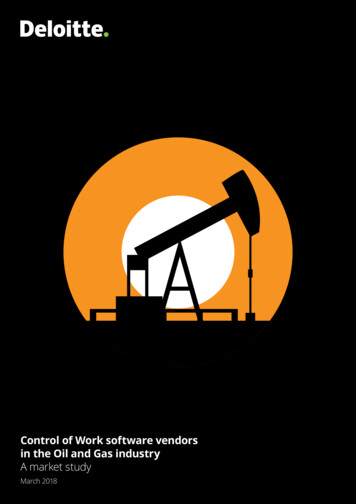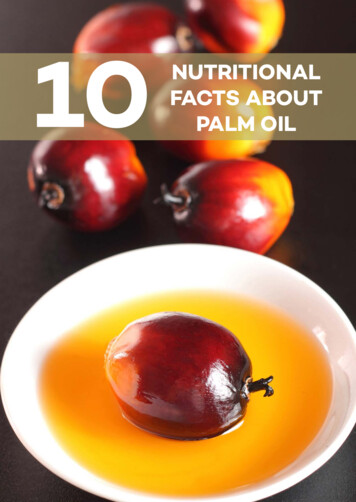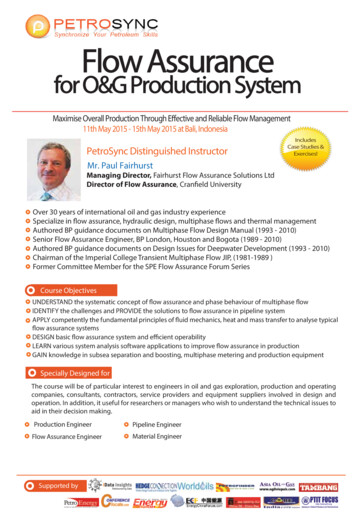
Transcription
Flow Assurancefor O&G Production SystemMaximise Overall Production Through Effective and Reliable Flow Management11th May 2015 - 15th May 2015 at Bali, IndonesiaPetroSync Distinguished InstructorIncludesCase Studies &Exercises!Mr. Paul FairhurstManaging Director, Fairhurst Flow Assurance Solutions LtdDirector of Flow Assurance, Cranfield UniversityOver 30 years of international oil and gas industry experienceSpecialize in flow assurance, hydraulic design, multiphase flows and thermal managementAuthored BP guidance documents on Multiphase Flow Design Manual (1993 - 2010)Senior Flow Assurance Engineer, BP London, Houston and Bogota (1989 - 2010)Authored BP guidance documents on Design Issues for Deepwater Development (1993 - 2010)Chairman of the Imperial College Transient Multiphase Flow JIP, (1981-1989 )Former Committee Member for the SPE Flow Assurance Forum SeriesCourse ObjectivesUNDERSTAND the systematic concept of flow assurance and phase behaviour of multiphase flowIDENTIFY the challenges and PROVIDE the solutions to flow assurance in pipeline systemAPPLY competently the fundamental principles of fluid mechanics, heat and mass transfer to analyse typicalflow assurance systemsDESIGN basic flow assurance system and efficient operabilityLEARN various system analysis software applications to improve flow assurance in productionGAIN knowledge in subsea separation and boosting, multiphase metering and production equipmentSpecially Designed forThe course will be of particular interest to engineers in oil and gas exploration, production and operatingcompanies, consultants, contractors, service providers and equipment suppliers involved in design andoperation. In addition, it useful for researchers or managers who wish to understand the technical issues toaid in their decision making.Production EngineerPipeline EngineerFlow Assurance EngineerMaterial EngineerSupported by
FLOW ASSURANCE FOR OIL AND GAS PRODUCTION SYSTEM11th May 2015 - 15th May 2015 at Bali, IndonesiaCourse OverviewFlow assurance is a key component in the design and operation of offshore production facilities. Asconventional oil reserves decline, companies are developing unconventional fields with complex fluidproperties. All these factors mean that flow assurance plays an increasingly important role in the oil and gasindustry and employers are frequently seeking skilled engineers in this field. This is particularly true as theindustry goes to deepwater, deeper wells and higher temperature and pressure reservoirs.This course will be cover the fundamentals of flow assurance and the phase behaviour of multiphase flow.Delegates will have an in-depth understanding of the systematic concept of flow assurance. Delegates will alsolearn the flow phenomena that can help to avoid problems such as hydrate formation, pressure waves, or highvicosity liquid flow failure.Furthermore, this course will cover potential challenges to pipeline operation including: surge, hydrateformation, wax deposition, multiphase fluids, and slugging. The causes of these issues, design solutions andsubsea operational will be an intergral part of the course. After the course, delegates will be able applycompetently the fundamental principles of fuild mechanics, heat and mass transfer to analyse typical flowassurance system. In addition, delegates will understand the elements of an operability report for subseaproduction facilities. Theories will be presented along with practical exercise on situational cases in applicationof the course.Course ContentDay One: Fundamentals of Flow AssuranceIntroduction of the CourseFlow Assurance- The flow assurance environment- Multiphase pipeline hydraulics- Production chemistry issues- Engineering the futureFundamentals of Multiphase Flow- Definitions- Flow Pattern prediction- Pipeline sizing (1), maximum and minimum velocity constraintsPhase Behaviour & Physical Properties- Compositional models, equations of state and phase diagrams- Black oil models, definition of propertiesClass Exercise: Magnus flow pattern determinationIN-HOUSE SOLUTIONSSAVE COST IMPROVE PERFORMANCE REDUCE RISKPetroSync understands that in current economic climate, getting an excellent return on your training investment is critical. This training can beconducted exclusively for your organization. The course can be tailored to meet your specific needs at your preferred location and time. We will meetyou anywhere around the globe.If you like to know more about this program, please contact Jerry Tay (Conference Director) on 65 6415 4502 or email jerry.t@petrosync.com
FLOW ASSURANCE FOR OIL AND GAS PRODUCTION SYSTEM11th May 2015 - 15th May 2015 at Bali, IndonesiaDay Two: Flow Assurance for Pipeline SystemProduction Chemistry- Properties of oil and condensate reservoir fluids- Fluid SamplingOil & Gas Pipeline Design- Pipeline sizing (2)- Thermal management- Design for wax- Design for hydrates- High viscosity issues- Solids transport- PiggingSlugging Flows (1)- Hydrodynamic slugging description andmodelling- CFD comparisons with hydrodynamic slug flowdataSlugging Flows (2)- Terrain induced slug flow- Severe slugging- Forces due to slugging- Piping layout- Slug catcher designDay Three: Hydrates and WaxHydrates and Wax- Description of hydrates and consequences offormation- Hydrate control methods- Testing for hydrates- Description of wax and consequences of deposition- Rheology of waxes- Pipeline cooldown and gel re-start- Testing for waxesGas/Condensate Pipeline Design- Pipeline sizing- Liquid inventory management- Influence of waterCase Study:- Girassol case study- Thermal management- Operating procedures- Hydrate remediationScale, Asphaltines and Napthenates- Scale types, testing and scale management- Occurance of asphaltines, laboratory testing andprediction- Properties of napthenates and mitigationPROGRAM SCHEDULE08:00 – 09:0009:00 – 11:0011:00 – 11:1511:15 – 13:0013:00 – 14:0014:00 – 15:3015:30 – 15:4515:45 – 17:0017:00Registration (Day1)Session IRefreshment & Networking Session ISession IILunchSession IIIRefreshment & Networking Session IISession IVEnd of DayHYBRID TRAINING SOLUTIONSFOCUSED TRAINING REDUCED COST ENHANCED RESULTSOver the years, there has been a growing demand for hybrid training programs. It is an excellent option to maximizeyour training dollar for your specific training needs. We make it possible to run a training program that is customizedto your training needs at a fraction of an in-house budget! If you like to know more about this program, pleasecontact us on 65 6415 4500 or email general@petrosync.com
FLOW ASSURANCE FOR OIL AND GAS PRODUCTION SYSTEM11th May 2015 - 15th May 2015 at Bali, IndonesiaDay Four: System Analysis and Software ApplicationSystem Analysis & PipeSim Software- Components of pressure loss- System design- Optimisation- PipeSim software demonstrationMaximus Software Demonstration- Description of Maximus software- Building a pipeline layout model in Maximus- Case studiesTransient Flows- Occurance of transient flows- Examples of ramp-ups, severe slugging, pigging, blowdown and cooldowns/warm-upClass Exercise- Pompano flowrate ramp-up- Determine theoretical ramp-up surge- Slug catcher sizingDay Five: Flow Assurance for Subsea DevelopmentOLGA Software Demonstration- Modelling in OLGA- Case studiesSubsea Separation and Boosting- Managing system energy- Multiphase pump types- Experience with multiphase boosting- Description of subsea separation technologies- Experience with subsea separationMultiphase Metering- Why we measure production rates- Advantages of multiphase metering- The technical challenges- The terms and definitions- The technology statusSubsea Wells and Completions- Tree configurations and equipment- Well and completion configurations- Subsea drilling and installation- Corrosion and corrosion control- Erosion, erosion/corrosion, design for erosion- New technologySubsea Production Equipment- Why choose subsea systems?- What is a subsea system- Designing a subsea system- Subsea wells- Manifolds and tie-ins- Flowlines and risers- Maintenance. Intervention and abandonment- New technologies and the futureIN-HOUSE SOLUTIONSSAVE COST IMPROVE PERFORMANCE REDUCE RISKPetroSync understands that in current economic climate, getting an excellent return on your training investment is critical. This training can beconducted exclusively for your organization. The course can be tailored to meet your specific needs at your preferred location and time. We will meetyou anywhere around the globe.If you like to know more about this program, please contact Jerry Tay (Conference Director) on 65 6415 4502 or email jerry.t@petrosync.com
FLOW ASSURANCE FOR OIL AND GAS PRODUCTION SYSTEM11th May 2015 - 15th May 2015 at Bali, IndonesiaPetrosync Distinguished InstructorMr. Paul FairhurstManaging Director, Fairhurst Flow Assurance Solutions LtdDirector of Flow Assurance, Cranfield UniversityPaul Fairhust is the managing director of his own oil and gas consultancy company which was formed in March2011. His principal focus is on Flow Assurance at an advanced stage providing reviews and guidance to FlowAssurance studies base on his 33 years of experience and expertise in Flow Assurance design tools and projects. Hisexpertise covers all aspects of upstream oil and gas project execution from concept selection, FEED, to detaileddesign and construction.Before starting his own consultancy company, Paul Fairhust was a Senior Flow Assurance Engineer for 21 years atBP Exploration. He is a leading expert in hydraulic design, multiphase flows and thermal management. As a seniorflow assurance engineer, he managed the multiphase flow R&D programme for BP worldwide by providing inputto QPR’s. He authored BP guidance documents on Design Issues for Deepwater Development and also the BPMultiphase Flow Design Manual. Additionally, he guided the BP software requirements on transient multiphaseflow simulation and produced a white paper on new-generation software tools. Paul also managed a validationsuite for testing commercial software products and was involved in numerous field trials and data analysisactivities, primarily related to slugging flows. He undertook numerous technical studies for BP and professionallyrepresented the company at partner meetings and peer reviews. He was the manager of the BP Multiphase FlowR&D program. Paul was involved in technical service work as well, where he was responsible for all BP’s work usingthe new breed of commercial transient multiphase flow simulators PLAC, OLGA, PeTra and TACITE including testingand validation studies.PROFESSIONAL ACTIVITIESChairman of the Imperial College Transient Multiphase Flow JIP 1981 - 1989Former committee member for the SPE Flow Assurance Forum SeriesMember of Institute of Petroleum (now Energy Institute) and was on the advisory committee for theDesign of Thermal Management Systems guidelines.Member of the Cranfield University Industrial Steering Committee of the Process Systems EngineeringMSc Course.PUBLICATIONSFairhurst, P.: “Multiphase 03”, Proceedings of the 11th International Conference on Multiphase 03, SanRemo, Italy, 11-13 June, 2003.Fairhurst, C.P and Barrett, N.: ”Oil/Water/Gas in Undulating Pipelines-Field Observations, ExperimentalData and Hydraulic Model Comparisons”, SPE Annual Technical Conference and Exhibition, SanAntonio, TX, 5-8 October, 1997.Fairhurst, C.P.: “Slug-Flow Behaviour Clarified in Large-Diameter Pipeline Study”, Oil & Gas Journal,October, 1988, pp49-57.Fairhurst, C.P.: “Pigging for Multi-Phase Flow Pipelines”, Chapter 6, Pipelines for Marginal Fields,published by Scientific Surveys, 1989.Fairhurst, C.P.: ”Multi-Phase Flow”, Proceedings of the 4th International Conference, Nice, France, 19-21June, 1989.
Course DetailsPROGRAMME CONSULTANTTitle: FLOW ASSURANCE FOR OIL AND GAS PRODUCTION SYSTEMDate: 11th May 2015 - 15th May 2015Location : Bali, IndonesiaName : Cay AagenEmail : registration@petrosync.comPhone : 65 6415 4500Fax: 65 6826 4322INVESTMENT PACKAGESInvestment PackagStandard Price8th MAY 2015Early Bird Offer10th APR 2015Group Discount(3 or more Delegates)TERMS AND CONDITIONSFULL MASTERCLASSDeadline8th MAY 2015DISCLAIMERSGD 5,995Please note that trainers and topics were confirmed atthe time of publishing; however, PetroSync maynecessitate substitutions, alterations or cancellations ofthe trainers or topics. As such, PetroSync reserves theright to change or cancel any part of its publishedprogramme due to unforeseen circumstances. Anysubstitutions or alterations will be updated on our webpage as soon as possible.SGD 5,79510% discount for groups of 3 registering from thesame organization at the same timeGroup Discount is based on Standard Price* To enjoy the promotion & discount offer, payment must be made before deadline* For 7 or more delegates, please inquire for more attractive package.* Prices include lunches, refreshments and materials. Promotion & discount cannot be combined with other promotional offers.* Important: Please note that registration without payment will incur a SGD 200 administration fee.DELEGATES DETAILS1st Delegate NameDirect Line Number:Email:Job d of Department:2nd Delegate NameDirect Line Number:Email:Job Title:Department:MrDirect Line Number:Email:Job Title:Department:The information you provide will be safeguarded byPetroSync that may be used to keep you informed ofrelevant products and services. As an internationalgroup we may transfer your data on a global basis forthe purpose indicated above. If you do not want us toshare your information with other reputable companies,please tick this boxCANCELLATION POLICYYou may substitute delegates at any time as long asreasonable advance notice is given to PetroSync. Forany cancellation received in writing not less thanfourteen (14) working days prior to the training course,you will receive credit voucher less a SGD 200administration fee and any
- Slug catcher sizing Day Five: Flow Assurance for Subsea Development OLGA Software Demonstration - Modelling in OLGA - Case studies Subsea Separation and Boosting - Managing system energy - Multiphase pump types - Experience with multiphase boosting - Description of subsea separation technologies - Experience with subsea separation Multiphase Metering - Why we measure


